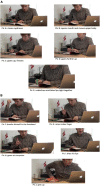Mind wandering in reading: An embodied approach
- PMID: 36936615
- PMCID: PMC10017976
- DOI: 10.3389/fnhum.2023.1061437
Mind wandering in reading: An embodied approach
Abstract
In the last 20 years, the study of mind wandering has attracted the attention of a growing number of researchers from fields like psychology, philosophy, and neuroscience. Mind wandering has been characterized in multiple ways: as task-unrelated, unintentional, stimulus-independent, or unguided thought processes. Those accounts have mostly focused on the identification of neurocognitive mechanisms that enable the emergence of mind-wandering episodes. Reading is one activity in which mind wandering frequently occurs, and it is widely accepted that mind wandering is detrimental for reading flow, comprehension and the capacity to make inferences based on the text. This mind wandering scepsis in reading is based on two unchallenged views: (i) that reading is a disembodied, mental activity of information processing, and (ii) that mind wandering is essentially characterized as a task-unrelated and involuntary thought process that disrupts all kinds of goal-oriented behavior. However, recent developments within cognitive science treat the mind as embodied and thus challenge both ontological and epistemological assumptions about what mind wandering is, where it is located, and how it is being studied empirically during reading. In this article we integrate embodied accounts of mind wandering and reading to show how reading benefits from nested mind wandering processes. Empirically, we investigate how a reader can move successfully in and out of different embodied processes and mesh different cognitive strategies over time, including some forms of mind wandering. While such changes in reading are frequently deemed dysfunctional, we suggest an alternative interpretation: Rather than seeking constant flow and fluency, we propose that reading is multi-actional and benefits from drawing on different cognitive strategies spanning mind wandering processes and goal-oriented behavior. In that sense, we suggest that mind wandering has a potential for enriching cognitive processes underlying reading, such as imagining and reflection. We exemplify these insights through analyses of data obtained in ethnographic and semi-experimental studies of reading practices. We conclude that to capture cognitive phenomena within an embodied framework, a richer methodology must be developed. Such a methodology must not only be capable of accounting for brains, bodies, and contexts in isolation, but must consider an overall brain-body-environment system.
Keywords: cognitive ethnography; embodied cognition; embodying mind wandering; mind wandering; phenomenology; reading.
Copyright © 2023 Trasmundi and Toro.
Conflict of interest statement
The authors declare that the research was conducted in the absence of any commercial or financial relationships that could be construed as a potential conflict of interest.
Figures
References
-
- Alsmith A. J. T., de Vignemont F. (2012). Embodying the mind and representing the body. Rev. Philos. Psychol. 3 1–13. 10.1007/s13164-012-0085-4 - DOI
-
- Andrews-Hanna J., Irving Z. C., Kieran C. R., Fox R., Spreng N., Christoff K. (2018). “The neuroscience of spontaneous thought: An evolving interdisciplinary field,” in The oxford handbook of spontaneous thought, eds Fox K., Christoff K. (Oxford: Oxford University Press; ). 10.1093/oxfordhb/9780190464745.013.33 - DOI
LinkOut - more resources
Full Text Sources



